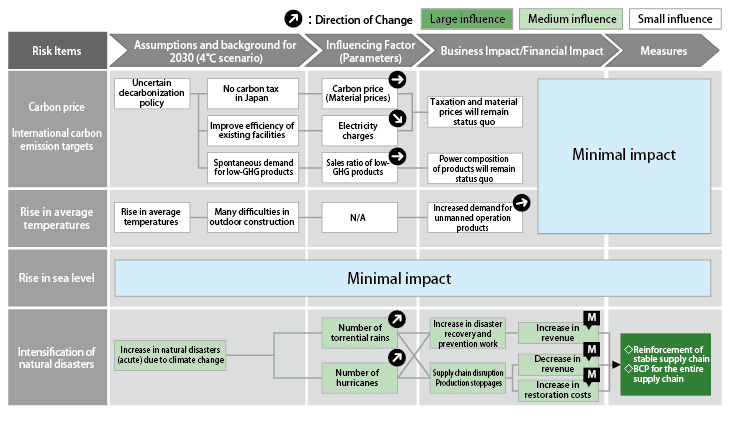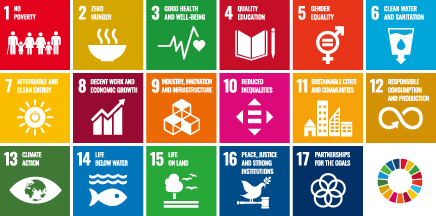Disclosure in line with TCFD Recommendations
Strategy
Steps in Scenario Analysis
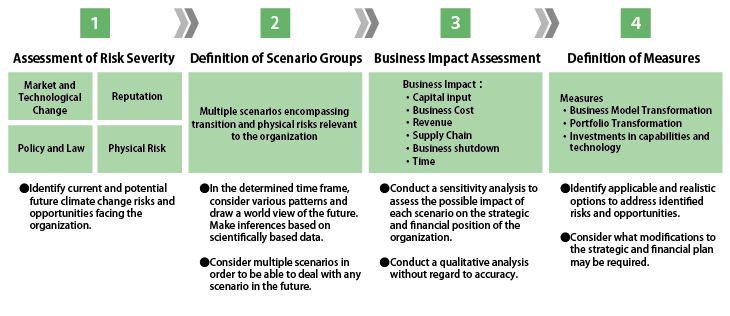
Assessment of Risk Severity
As a preliminary step in selecting a set of scenarios related to climate change, we referred to the typology of climate-related risks in the TCFD recommendations and identified risks and opportunities that could affect the Group's business.
| Types by TCFD | Classification | Time of Occurrence | Risk | Severity | Opportunity | Size | |||
|---|---|---|---|---|---|---|---|---|---|
| Short-term | Mid-term | Long-term | |||||||
| Transition Risks | Policy and Legal | Carbon price | Increase in raw material prices (steel, rubber, glass, etc.) due to introduction of carbon tax | Large | Reduction of energy consumption charges through the installation of energy-saving equipment | Small | |||
| Orders and regulations for existing products and services | Decrease in sales of existing products due to GHG emission regulations | Large | Increase in sales of low-GHG products due to GHG emission regulations | Large | |||||
| Increased R&D costs to comply with GHG emission regulations | Medium | ||||||||
| Tighter regulations in the shipping industry | Increase in shipping costs due to the cost of building new low-GHG ships and passing on the cost of acquiring emission credits | Large | |||||||
| Technology | Substitution of existing products and services with lower GHG emissions | Decrease in sales of existing products due to GHG emission regulations | Large | Increase in sales of low-GHG products due to GHG emission regulations | Large | ||||
| Transition to low GHG emission technologies | Increased R&D costs to comply with GHG emission regulations | Medium | |||||||
| Market | Rising energy prices | Increased plant operating costs | Small | ||||||
| Changing customer behavior | Decrease in sales of existing products due to shift in demand to low-GHG products | Large | Increase in sales of low-GHG products due to shift in demand to low-GHG products | Large | |||||
| Reputation | Stakeholder reputation | Delayed action on climate change causes stock price declines, higher capital costs, and difficulty in securing human capital | Medium | ||||||
| Physical Risks | Acute | Increased severity and frequency of extreme weather events | Supply chain disruptions, production stoppages, and lost sales opportunities due to severe natural disasters | Medium | Increased demand for products due to an increase in disaster recovery and disaster prevention work | Medium | |||
| Chronic | Rising average temperatures, rising sea levels | Increased temperatures make it more difficult to work at construction sites | Small | ||||||
* Click here to download the above table (PDF). ![]()
* The Time of Occurrence indicates the following
Short-term: Within 3 years
Mid-term: In the next 3 to 5 years
Long-term: More than 5 years
Definition of Scenario Groups
The TCFD recommends that a company "Describe the resilience of the organization’s strategy, taking into consideration different climate-related scenarios, including a 2°C or lower scenario.” In our scenario analysis, we referred to the Sixth Assessment Report (AR6) published by the Intergovernmental Panel on Climate Change (IPCC) and the IEA’s World Energy Outlook 2021, and selected the "2°C Scenario," a socioeconomic scenario that emphasizes sustainability, and the "4°C Scenario," a current transition scenario. The time horizon for the analysis is 2030.
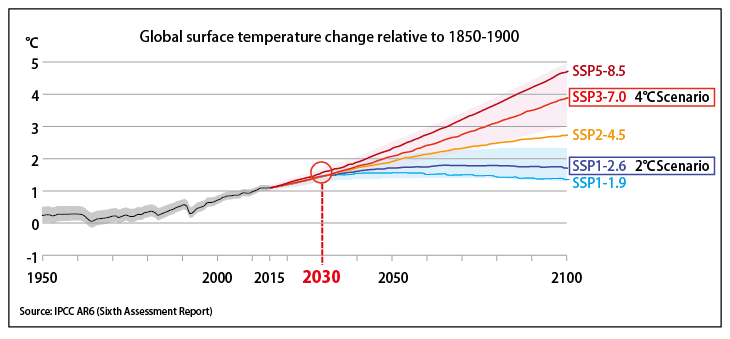
*External information referred to in the definition of scenario groups
◇ Intergovernmental Panel on Climate Change (IPCC) "SSP1-2.6 Scenario and SSP3-7.0 Scenario of the Sixth Assessment Report (AR6)”
◇ International Energy Agency (IEA) "APS and STEPS Scenarios of the World Energy Outlook 2021 (WEO-2021)"
| 2°C Scenario (sustainability-oriented) | 4°C Scenario (current transition) |
|---|---|
|
Scenarios with high policy transition impact
|
Scenarios with high physical impact
|
2°C Scenario Analysis, Worldview in 2030 (Five Force Analysis)
Tighter decarbonization policies around the world will lead to tighter regulations on the use of fossil fuels and raw materials. Consumer interest in decarbonization will increase markedly. These factors will result in higher raw material costs, higher ocean freight costs, higher development costs, greater investment in plant and equipment, and higher demand for low-GHG products (i.e., lower demand for conventional products with diesel engines) for the Group's businesses.
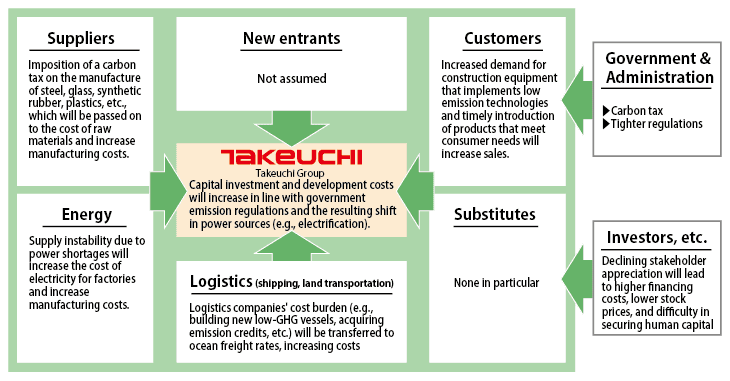
4°C Scenario Analysis, Worldview in 2030 (Five Force Analysis)
Countries' decarbonization policies are uncertain, and regulations on the use of fossil fuels are not strong. Consumer interest in decarbonization will only increase spontaneously. These factors will have an impact on the Group's business: supply chains will be disrupted due to the severity of natural disasters, sales opportunities will be lost due to production stoppages, but demand will increase due to increased disaster recovery work and disaster prevention projects.
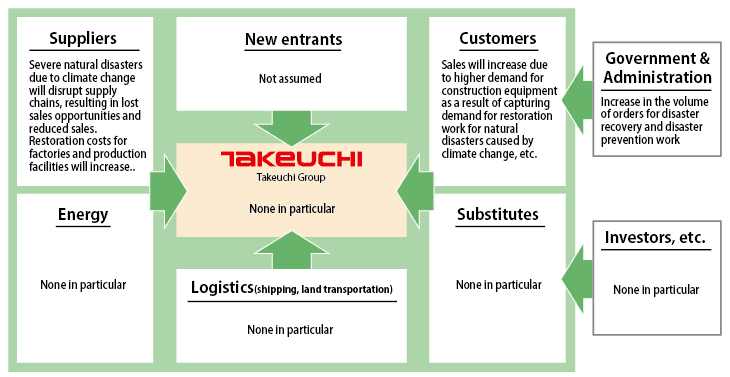
Business Impact Assessment, and Definition of Measures
Using logic trees, we have organized the expected flow of manifesting climate change impacts and response measures by scenario. With the Paris Agreement, the international community has agreed to limit the increase in the global average temperature to within 2°C, and interest in and expectations for corporate climate change countermeasures have increased. Climate change occurs over a medium- to long-term time horizon and is highly uncertain due to the wide range of predictions. Nevertheless, we will accept an uncertain and broad future and consider the impact of and the measures in response to climate change, thus enabling us to incorporate resilience into our management strategy to respond flexibly to climate change.
Since this is the first stage of scenario analysis, we have not quantitatively calculated the business and financial impacts, but have classified the impacts into large, medium, and small based on a qualitative assessment of the likelihood and timing of the risk materializing and the degree of significance if it does materialize.
Logic Tree for 2°C Scenario in 2030
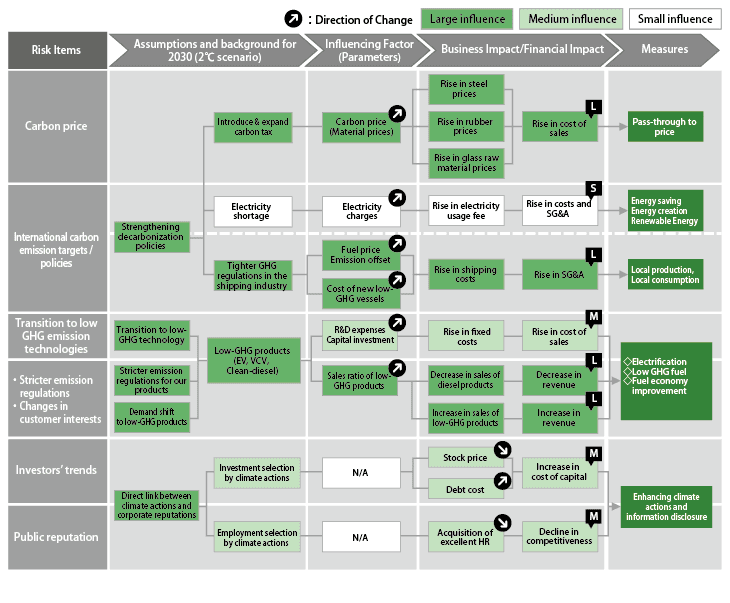
Logic Tree for 4°C Scenario in 2030
